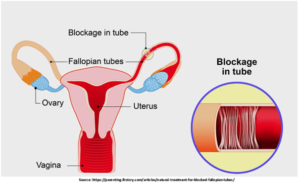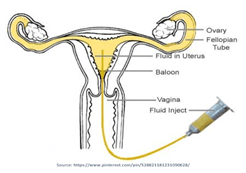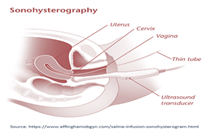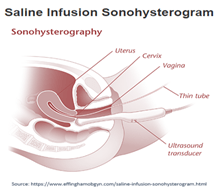Tubal Blockage Treatment in India
The egg is released from the ovary by the process of ovulation. Further, the egg enters the fallopian tubes, where a motile sperm fertilizes it to develop an embryo.
After five days, the 150-celled blastocyst reaches the uterus. For further development,itimplants in the upper portion of the cavity. Eventually, after nine months, the labour begins, and the foetus gets delivered. A woman requires at least one functional, open fallopian tube for natural or artificial pregnancy through insemination.
Conditions like pelvic inflammatory disease, endometriosis, or infection may cause blockage in the fallopian tube. It may obstruct the passage of sperm to the egg, and the way to the uterus for the fertilized egg, resulting in failed conception.

The tubal blockages should be treated on time to achieve a healthy pregnancy and avoid adverse complications. Tubal blockage removing procedures are complex and require immense skills and expertise; hence, they should be treated by an expert. Dr. Hrishikesh Pai has extensive experience of 40+ years in obstetrics, gynecological, and assisted reproductive procedures.Also, Dr. Pai provides advanced and effective tubal blockage treatment in India.
Moreover, Dr. Hrishikesh Pai is best known for his expertise and skills as one of the best IVF doctor in India. Dr. Hrishikesh Pai is the medical director and founder of the Bloom IVF group. The Bloom IVF is one of the best IVF centre in India, holding nine IVF centres across India.
CONTACT US FOR MORE INFORMATION OR BOOK AN APPOINTMENT
What is Tubal Blockage or Hydrosalpinx?

Tubal blockage or hydrosalpinx is a condition wherein the fallopian tubes are severely diseased, swollen, and blocked, resulting in fluid collection.
A hydrosalpinx blockage usually occurs near the ovaries at the far end of the fallopian tube. However, it can also happen at either end as the ovaries and the uterus are connected by fallopian tubes. Thus, any blockage in the fallopian tubes can impair the female reproductive system’s regular functioning. If both fallopian tubes are damaged, it causes hydrosalpinges.
The fallopian tubes are responsible for transferring a fertilized egg (embryo) to the uterus for successful conception. Adhesions and irritations caused by hydrosalpinx produce blockage in fallopian tubes resulting in infertility. Although it is possible to achieve pregnancy with only one functioning fallopian tube, conception rates are lower.
Causes of Tubal Blockage
- Pelvic Inflammatory Disease (PID): The fallopian tubes, ovaries, and uterus are all affected by PID infection. Chlamydia and Gonorrhoea commonly cause PIDs. Chronic PID may result in hydrosalpinx.
- Adhesions: Adhesions from past pelvic surgeries can also cause hydrosalpinx.
- Appendicitis Burst: When an appendix bursts, it can cause infections in the pelvic area, leading to hydrosalpinx.
Some of the other causes of tubal blockage are:
- Endometriosis
- Previous stomach surgery
- Prior ectopic pregnancy
- Past surgery or trauma relating to fallopian tubes
- Abortion or unnatural birth cycle
- Contraction of STDs
Symptoms of Tubal Blockage
In most cases, the patient may not experience any symptoms and may know the condition only after diagnosing infertility.
- Infertility: – It is a significant symptom of hydrosalpinx.
- Pain and abnormal discharge: – In some cases, pelvic discomfort and irregular vaginal discharge occur.
- Symptoms of the root cause: – The patient may experience the root cause symptoms, like in PID; the patient may suffer from:
-
- Lower abdominal pain
- Cervical motion tenderness
- Severely painful periods
- Painful sexual intercourse
How is Tubal Blockage Diagnosed?
Generally, IUI is more affordable than other assisted reproductive technologies like IVF, ICSI, and IMSI.
IUI treatment cost in India varies depending on several factors, such as:
- the clinic’s reputation
- location
- the expertise of the fertility specialist
The overall cost usually includes pre-treatment evaluations, medications, the IUI procedure, and post-procedure follow-ups. Some clinics may offer package deals that cover multiple IUI cycles, providing a more cost-effective approach for couples seeking fertility assistance.
If you plan on undergoing IUI treatment in Mumbai, please consult fertility specialist Dr. Hrishikesh Pai to get a detailed breakdown of the expenses in your specific case.
CONTACT US FOR MORE INFORMATION OR BOOK AN APPOINTMENT
Tubal Blockage Treatment in India
- The course of tubal blockage treatment in India depends on the extent of the condition and patient preferences.
- In bilateral tubal blockage, the most severe infection that should be ruled out is genital tuberculosis. If present, the patient should start anti-tubercular treatment for 6 to 9 months. Following this, the doctor can recommend IVF or ICSI to achieve pregnancy.
- Sometimes, debris or secretions block the fallopian tubes. Surgeons can open these blockages using tubal cannulation with a Terumo guidewire under laparoscopic – hysteroscopic control or fluoroscopic control.
- Besides, the patient who opts for fallopian tubal recanalization surgery – FTR can have unprompted pregnancy success ratesvarying from 30% to 50%, depending on the part of the tube affected. If the patient fails to get pregnant with FTR, or if the tubes are severely diseased, it is betterto choose IVF or ICSI.
- If a hydrosalpinx is present and is > 2 cm thick or is visible on ultrasound, it is best to remove it before IVF, as the hydrosalpinx discharges its secretions into the uterine cavity, hampering the embryo implantation.
- Sometimes, due to severe adhesions to surrounding structures such as bowels, it is tough to remove the hydrosalpinx. Also, if the surgeon tries to remove such difficult hydrosalpinges, the ovarian blood supply can get hampered, resulting in depletion of ovarian reserve. Therefore, it is better to disconnect the hydrosalpinx using cautery, ligature, or harmonic scalpel in such conditions.
- The surgeons can also block the hydrosalpinx by applying a clip at the fallopian tube and uterus junction. After removing hydrosalpinx, there is an improvement of pregnancy rate by as much as 50 % before IVF.
If you face difficulty conceiving, book an appointment with Dr. Hrishikesh Pai to get the most suitable and effective fertility treatment.
Frequently Asked Questions
Can tubal blockage affect the menstrual cycle?
Except for mild pain or discomfort, tubal blockage does not affect the menstrual cycle. However, disorders that cause the blockage can damage the ovaries and endometrium, causing irregular or heavy periods.
Can abortion cause tubal blockage?
Abortion can result in severe uterine injury, intestinal injury, and severe infections. Furthermore, it might impact fertility by scarring the uterus and fallopian tubes. In addition, women who require a hysterectomy to treat the complications of an unsafe abortion may lose their fertility as well.
Why is the HSG examination painful?
The dye passes through the uterus, the fallopian tubes, and the abdominal cavityin many women. As a result, the dye might produce pressure where is a blockage and cause pain.
When will the patient know about the tubal blockage?
Symptoms of tubal blockage are uncommon. Many women are unaware that they have tubal blockage until they experience complications. Hydrosalpinx can cause modest and persistent pain in one area of the stomach in some cases.






